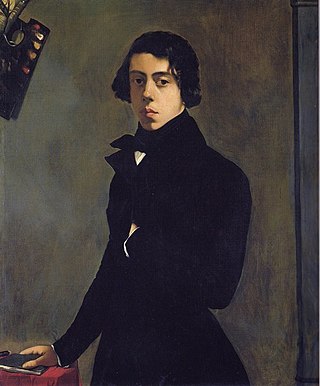
Ferdinand Victor Eugène Delacroix was a French Romantic artist regarded from the outset of his career as the leader of the French Romantic school.

French Algeria, also known as Colonial Algeria, was the period of Algerian history when the region was a colony and later a part of France. French rule in the region began after the French successful invasion of Algeria and lasted until the end of the Algerian War leading to its independence in 1962. After being a French colony from 1830 to 1848, Algeria was a part of France from 4 November 1848 when the Constitution of French Second Republic took effect until its independence on 5 July 1962.

Théodore Chassériau was a Dominican-born French Romantic painter noted for his portraits, historical and religious paintings, allegorical murals, and Orientalist images inspired by his travels to Algeria. Early in his career he painted in a Neoclassical style close to that of his teacher Jean-Auguste-Dominique Ingres, but in his later works he was strongly influenced by the Romantic style of Eugène Delacroix. He was a prolific draftsman, and made a suite of prints to illustrate Shakespeare's Othello. The portrait he painted at the age of 15 of Prosper Marilhat, makes Théodore Chassériau the youngest painter exhibited at the Louvre museum.

MoulayAbd al-Rahman bin Hisham, born on 19 February 1778 in Fes and died on 28 August 1859 in Meknes, was a sultan of Morocco from 30 November 1822 to 28 August 1859, as a ruler of the 'Alawi dynasty. He was a son of Moulay Hisham. He was proclaimed sultan in Fes after the death of Moulay Sulayman.

The Battle of Isly was fought on August 14, 1844 between France and Morocco, near the Isly River. French forces under Marshal Thomas Robert Bugeaud routed a much larger, but poorly organized, Moroccan force, mainly fighters from the tribes of Beni Snassen, but also from the Beni Angad and Beni Oukil; under Muhammad, son of the Sultan of Morocco, Abd al-Rahman. Bugeaud, attempting to complete the French conquest of Algeria, instigated the battle without a declaration of war in order to force negotiations concerning Moroccan support for the Algerian resistance leader Abd el-Kader to conclude on terms favorable to the French who demanded the Sultan of Morocco to withdraw support for Abd el-Kader.

Women of Algiers in their Apartment is the title of two oil on canvas paintings by the French Romantic painter Eugène Delacroix.

Eugène Louis Gabriel Isabey was a French painter, lithographer and watercolorist in the Romantic style.

Charles-François Delacroix was a French statesman who became Minister of Foreign Affairs under the Directory. The painter Eugène Delacroix was his fourth son, although doubts have been cast on his paternity.

The Musée national Eugène Delacroix, also known as the Musée Delacroix, is an art museum dedicated to painter Eugène Delacroix (1798–1863) and located in the 6th arrondissement at 6, rue de Furstenberg, Paris, France. It is open daily except Tuesday; an admission fee is charged.

The French conquest of Algeria took place between 1830 and 1903. In 1827, an argument between Hussein Dey, the ruler of the Deylik of Algiers, and the French consul escalated into a blockade, following which the July Monarchy of France invaded and quickly seized Algiers in 1830, and seized other coastal communities. Amid internal political strife in France, decisions were repeatedly taken to retain control of the territory, and additional military forces were brought in over the following years to quell resistance in the interior of the country.

Baron Charles Frédéric Chassériau du Chiron was a Saint Dominican architect and painter, who served as chief architect of the cities of Marseille, Algiers, in Algeria; and Cairo, in Egypt. He is particularly known for having designed the seafront of the city of Algiers.

The National Museum of Fine Arts in Algiers is one of the largest art museums in Africa. Opened to the public since 5 May 1930, it is located in the Hamma district, next to the Hamma test garden.

Henri Duponchel was in turn a French architect, interior designer, costume designer, stage designer, stage director, managing director of the Paris Opera, and a silversmith. He has often been confused with Charles-Edmond Duponchel, a contemporary who also lived and worked in Paris.
The artist André Hambourg was a French painter of romantic compositions of Venice, luminous seascapes, and beach scenes.

Jean Seignemartin was a French painter of the Lyon School.

Arab Horses Fighting in a Stable is an 1860 Orientalist painting by Eugène Delacroix, signed and dated by the artist and now in the musée d'Orsay.

The Sultan of Morocco is an 1845 oil on canvas painting by the French Romantic and Orientalist painter Eugène Delacroix, now in the Musée des Augustins de Toulouse. Its full title is Moulay Abd-Er-Rahman, Sultan of Morocco, leaving his palace of Meknès, surrounded by his guards and his principal officers. It shows Sultan Abd al-Rahman of Morocco.

Louis Ferdinand Antoni was a French Orientalist painter and sculptor.
Mustapha ibn Muhieddine, known as Emir Mustapha, Sidi Moustafa, Moustafa El Hassani El Djazairi, was an Algerian religious and military leader who led a struggle against the French colonial invasion in the mid-19th century with his brother, Emir Abdelkader.

The French Consulate General in Tangier is one of the consular representations of the French Republic in Morocco. It has a rich history linked to Tangier's past role as diplomatic capital of the Sultanate of Morocco from the late 18th to the 20th centuries.





















